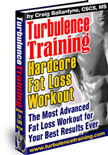Mad Scientist Dishes Out Workout and Nutrition Advice
 Hey folks! We’re moving into part 2 of my expert interview with the Mad Scientist, Nick Nilsson. If you missed it, make sure you jump back to part 1 where you’ll discover the meaning behind Nilsson’s nickname and how he can help you overcome any workout plateau.
Hey folks! We’re moving into part 2 of my expert interview with the Mad Scientist, Nick Nilsson. If you missed it, make sure you jump back to part 1 where you’ll discover the meaning behind Nilsson’s nickname and how he can help you overcome any workout plateau.
Today, the Scientist is going to share with us why he thinks the best muscle building workouts mimic that of a car driving uphill. It’s an interesting analogy, but when you think about it, it totally makes sense. So let’s find out about this and some of Nilsson’s other strategies for fat loss and gaining muscle.
********************
Craig Ballantyne: Let’s talk about muscle building first. Sets, reps, frequency, that type of stuff.
Nick Nilsson: I’d have to say the BEST muscle building exercise program that I’ve done alternates between high volume and moderate intensity to low volume with a little higher intensity. So, you’re going back and forth between a few different extremes by increasing the volume.
This way you’re getting a TOTAL BODY WORKOUT three or four days a week.
You’ll be hitting your muscles very frequently with a lot of volume each time. Do that until your body is getting to the point where you’re almost at fatigue. This is the kind of training where you are on the edge of over training when you really start piling up.
As you back off and allow your body time to recover you get even better results. Because your body is still in gear from the higher volume training and then you back off and give it more time to recover.
The ANALOGY I like to use is when you’re in a car going up the hill you’ve got it floored, and you just keep moving at a slow pace. When you come over the top of the hill if you keep that pedal floored you’re going to be picking up speed really fast. That’s kind of the analogy that I like to use in terms of the best muscle building programs out there.
That’s generally how I like to design my programs.
Craig Ballantyne: How long are you looking at the uphill phase to when you switch to the downhill phase? Do you take any rest? How do you change things up?
Nick Nilsson: It depends on the program. One of my muscle building programs is designed to be done in a month. Basically, I’ll take two weeks just to hammer the body and then two weeks to back off. The next two weeks I’ll train at a higher volume then back off for two weeks, giving the body one week of rest. So, I’m basically taking one week completely off after eight weeks of training in a row.
In my moderate program I do three to four weeks of each phase and just let the results be your guide, especially during the backing off phase. But, during the high volume phase you will come to a point where your body says, “I need to rest, I need a break.” Then you back off and let it coast.
It’s not like you’re training easy, but you’re backing off on the volume and increasing the loads that you’re using.
Craig Ballantyne: Very nice. What about fat loss? Switching over, do you have a similar way of doing things?
Nick Nilsson: I actually do. I’ve found that this kind of approach basically is just mostly CHANGING the diet and eating FEWER calories, eating cleaner.
So, I do a higher volume when I’m eating low carbs and then back off when I am eating low fat meals, so you’re still eating low calories, but you’re changing the focus of your training to more of a muscle building program. I’ve found going back and forth really keeps your body from losing muscle, and it’s a really effective way to keep your body from hitting any plateaus as well.
Craig Ballantyne: Very cool. When you’re talking about nutrition, what kind of approach do you have for fat loss? 
Nick Nilsson: For fat loss, I’m actually a FAN of low carb eating for part of it and for limited periods.
The reason it’s limited is that you don’t want to stay on it too long, because you will start to plateau and actually lose muscle and a lot of energy. I’ve found that five or six days on that is about the most you should do before switching to a low fat approach.
When I’m doing a fat loss program I tend to not do a steady state approach where some people will recommend doing a few hundred calories below maintenance, which is totally fine and does work, but for me, I’ve found it better for my results alternating between low carb and low fat, and keeping the calories low.
Alternating back and forth is what prevents your body from basically getting used to any one thing, aka Turbulence Training.
Craig Ballantyne: Sure. Turbulence Diet, there you go.
Nick Nilsson: That’s right.
Craig Ballantyne: So, in muscle building, how do you change things?
Nick Nilsson: With muscle building it’s a lot of different things. I like to use a lot of different techniques. I tend to STAY AWAY FROM going to muscular failure with muscle building these days. When I was younger I used to do a lot of that and I think I should have gotten better results, because I’ve found I get better results by pulling back a little bit and not pushing things quite as hard.
Actually for MUSCLE BUILDING I prefer to do more of a higher volume higher frequency approach. I find instead of doing one body part per day program that a lot of people do like to use, especially bodybuilders, doesn’t work for me at all, I need to do more.
The training I like to do with a FAT LOSS program is much more targeted to what kind of nutrients you’re eating. For example, if you’re doing more of a low carb focus then you’d want to adjust things so you’re not going complete failure. You’re using kind of a high intensity program and you’re focusing more on lactic acid, which is a great way to hormonally burn fat, because that increases growth hormone, which in turn is a very potent fat burning hormone.
The idea is basically to train more frequently so you’re hitting the muscle more frequently, but not killing it as hard each time so it doesn’t dip into your recovery energy quite as much.
 Craig Ballantyne: How often do you train frequently then? Are you hitting the same muscle group twice in five or six days?
Craig Ballantyne: How often do you train frequently then? Are you hitting the same muscle group twice in five or six days?
Nick Nilsson: Yes. It’s usually about twice a week. I’ve gone actually as high as really insane levels of frequency where I’ve done two a day workouts hitting my total body every time for two days, so basically 12 times a week.
Craig Ballantyne: Wow.
Nick Nilsson: During that period I was actually on vacation. I used to work on cruise ships and I was on vacation during that time and doing nothing but eating, sleeping, and training. It’s not like a general program that I’d recommend for most people. But, for me that was incredibly effective. That kind of frequency is on the extreme for sure.
I think a lot of people tend not to train their body parts as frequently as they should and they do too much at once rather than pulling back a little bit on the amount of stuff they’re doing, but just doing it a little bit more frequently.
Craig Ballantyne: So, not necessarily on that particular program, but on a regular one, are you suggesting two exercises of chest one day and then two different exercises of chest another day?
Nick Nilsson: Yes, something along that line. It would be more like if you’re doing chest on Monday, you do a couple exercises and then repeat it on Thursday, that kind of thing.
Craig Ballantyne: Okay. So, you’re looking at six to eight sets?
Nick Nilsson: About that, yes.
Craig Ballantyne: Okay. Very good. What I actually meant to ask you was nutrition for muscle building, what approach are you taking there?
Nick Nilsson: I actually have two different philosophies with that and it depends totally on the kind of program that you’re using. If it’s more of a steady muscle building kind of program I’ll do a very basically high volume eating as well.
What I tend to do with my nutrition is I don’t eat as frequently as a lot of people recommend, I actually stick to three or sometimes four meals a day. I’ll have big breakfast, a small lunch, and a big post-workout meal. For me that really works well, because I tend to have an appetite that if I’m eating a big meal I just stuff myself silly and I can’t eat again for like six hours.
Craig Ballantyne: Okay.
Nick Nilsson: So, I kind of work with that and have a big breakfast so I’m not hungry again until the afternoon, then have small lunch, train kind of in the early evening, and then a big meal right after a workout. That seems to really work well for me.
If the program I’m doing is more of an acute kind of thing, for example the muscle building program that I have out right now called Muscle Explosion, the first week actually is a very strict low calorie diet, which basically draws out all the carbs to set your body to rebound the following week.
That’s kind of the slingshot approach, as I call it. It’s basically like when you come off a low carb diet and your body carbs up. It flushes a lot of nutrients into your muscles. I’ve found that’s a great way to take advantage and force your body to add on some muscle.
So, those are the approaches that I take. One is sort of a very instantaneous kind of power focus approach and one is more of a long term keep the calories high, keep the protein high kind of approach.